Figure 1. Key parameters of polymer microparticle design.
The chemical functionalities of the polymer affect essentially all aspects of microparticle performance, including the efficiency of drug encapsulation, the rate of polymer degradation and drug release, and toxicity at the injection site. a | The porous structure of the polymer alllows penetration of water and facilitates its degradation and subsequent drug release. The porosity of the polymer also affects the diffusion of the drug. b | The size of the microsphere particles affects the duration of drug release (in general, larger particles lead to more prolonged release) and the size of the needle required for administration (smaller needles are required for smaller particles). c | Polydispersity of particle size may introduce variability in the release rates. d | Particle surface properties affect their interactions with the surroundings at the injection site, especially immune cells. Modification of the surface with polymers such as polyethylene glycol (PEG) is used to modulate the interactions of the microsphere with immune cells. e | The shape of the polymer affects the interactions of particles with macrophages; elongated particles exhibit orientation-dependent internalization by macrophages.

